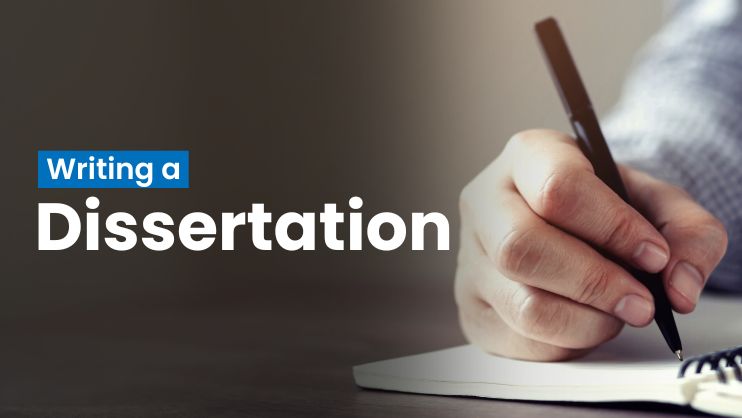Writing a dissertation is a crucial step in your academic journey, especially for postgraduate students. It serves as a demonstration of your research abilities, analytical thinking, and writing skills. This guide provides essential insights into writing a dissertation while maintaining keyword density and incorporating important elements like structure, formatting, and defense.
Table Of Content
- What Is a Dissertation? | Guide, Examples, & Template
- Dissertation Committee and Prospectus Process
- Understanding the Purpose of a Dissertation
- Choosing a Research Topic
- Conducting a Literature Review
- Developing a Research Proposal
- How to Write and Structure a Dissertation
- Research Methodology
- Time Management and Organization
- Academic Writing and Clarity
- Ethical Considerations
- Editing and Proofreading
- Preparing for the Dissertation Defense
- Submission and Final Review
- Key Sections of a Dissertation
- Final Thoughts
What Is a Dissertation? | Guide, Examples, & Template
A dissertation is a long-form academic document that presents original research on a specific topic. Unlike essays and term papers, a dissertation requires extensive research, data analysis, and critical evaluation. Understanding its components and process is essential for academic success.
Dissertation Committee and Prospectus Process
Before beginning your dissertation, you need approval from a dissertation committee. This committee provides guidance, evaluates your research prospectus, and ensures your research aligns with academic standards. The prospectus outlines the research problem, objectives, methodology, and expected outcomes. Below are essential things to know when writing a dissertation.
Understanding the Purpose of a Dissertation
A dissertation is a comprehensive research project that allows students to explore a specific topic in-depth. The primary objectives of a dissertation include:
- Demonstrating an understanding of the research topic.
- Applying theoretical and practical knowledge to analyze issues critically.
- Presenting original findings or interpretations.
- Showcasing independent research and academic writing skills.
Choosing a Research Topic
Selecting the right topic is crucial as it sets the foundation for your entire dissertation. Consider the following when choosing a topic:
- Interest and Passion: Choose a topic that genuinely interests you.
- Relevance: Ensure the topic is relevant to your field of study and contributes to existing research.
- Feasibility: Assess whether the topic is researchable within the given time frame and resources.
- Clarity and Scope: Avoid overly broad or extremely narrow topics.
Conducting a Literature Review
A literature review provides an overview of existing research related to your topic. It helps to:
- Identify gaps in current research.
- Establish theoretical frameworks.
- Justify your research by showing how it builds on previous studies.
- Avoid duplication of research.
Use academic sources such as books, peer-reviewed journals, and credible online databases like Google Scholar, JSTOR, and PubMed. Organize your literature review thematically to present a clear and logical analysis.
Developing a Research Proposal
Before starting your dissertation, many institutions require a research proposal. This outlines your study’s objectives, significance, methodology, and expected outcomes. A strong proposal includes:
- A clear research question or hypothesis.
- A review of relevant literature.
- A well-defined research methodology.
- Ethical considerations and limitations of the study.
How to Write and Structure a Dissertation
A well-structured dissertation enhances readability and ensures clarity. The following sections must be included:
Title Page
The title page contains your dissertation title, your name, institution, department, supervisor’s name, and submission date. Ensure that it follows university formatting guidelines.
Acknowledgements or Preface
This section allows you to express gratitude to those who supported you during your research journey, including advisors, colleagues, and family.
Abstract
An abstract provides a concise summary of your dissertation, covering research objectives, methodology, key findings, and conclusions. It should be around 150-300 words.
Table of Contents
The table of contents outlines the dissertation’s structure and helps readers navigate different sections easily.
List of Figures and Tables
If your dissertation includes charts, graphs, or tables, list them separately for easy reference.
List of Abbreviations
If your research includes technical abbreviations, provide a list to help readers understand their meanings.
Glossary
A glossary defines key terms and concepts used throughout the dissertation.
Research Methodology
Your research methodology depends on your discipline and research question. Common methodologies include:
- Quantitative Research: Involves statistical analysis, surveys, and experiments.
- Qualitative Research: Uses interviews, case studies, and thematic analysis.
- Mixed Methods: Combines both qualitative and quantitative approaches for comprehensive analysis.
Time Management and Organization
Writing a dissertation is a time-intensive process. Plan effectively by:
- Creating a timeline with deadlines for each section.
- Setting realistic daily or weekly writing goals.
- Staying organized by keeping research notes, drafts, and references well-documented.
Use tools like Microsoft Word, Google Docs, or LaTeX for writing and reference management software like EndNote, Zotero, or Mendeley.
Academic Writing and Clarity
A dissertation should be written in a formal, clear, and concise manner. Tips for effective academic writing include:
- Clarity: Avoid jargon and ambiguous statements.
- Precision: Ensure arguments are well-supported with evidence.
- Consistency: Follow a structured format and maintain logical flow.
- Grammar and Style: Proofread for grammatical errors and adhere to your institution’s formatting guidelines.
Ethical Considerations
Research ethics are fundamental, especially when working with human subjects. Ethical considerations include:
- Obtaining informed consent from participants.
- Ensuring confidentiality and anonymity.
- Avoiding plagiarism by properly citing all sources.
Check your university’s guidelines for ethical research and plagiarism policies.
Editing and Proofreading
Once the writing phase is complete, thorough editing and proofreading are essential. Consider:
- Self-Editing: Read through your dissertation to refine arguments and improve coherence.
- Grammar and Spell-Check Tools: Use tools like Grammarly or Hemingway Editor.
- Peer Review: Ask colleagues or mentors for feedback.
- Professional Editing: Consider hiring an editor for final polishing.
Preparing for the Dissertation Defense
For doctoral and some master’s students, a dissertation defense is required. This involves presenting your research findings to a committee. Tips for success include:
- Practicing your presentation and anticipating questions.
- Clearly articulating your research contributions.
- Defending your methodology and findings confidently.
Submission and Final Review
Before submitting your dissertation, ensure you:
- Follow the submission guidelines provided by your institution.
- Format the document correctly.
- Submit any required supplementary documents.
Key Sections of a Dissertation
Introduction
The introduction provides background information on the topic, research objectives, significance, and research questions. It should set the stage for your study.
Literature Review
This section critically analyzes existing research related to your topic. It identifies gaps, theoretical frameworks, and relevant studies to support your research.
Methodology
The methodology explains your research approach, data collection methods, and analysis techniques. It should justify why certain methods were chosen and how they contribute to the study.
Results
This section presents the findings of your research, often including statistical analysis, graphs, and tables. It should be objective and data-driven.
Discussion
The discussion interprets the results in relation to the research questions. It explores implications, limitations, and potential applications of the findings.
Conclusion
The conclusion summarizes the key findings, highlights contributions to the field, and suggests future research directions.
Reference List
A reference list includes all sources cited in the dissertation, formatted according to the required citation style (APA, MLA, Chicago, etc.).
Appendices
Appendices contain supplementary materials such as questionnaires, raw data, and additional documents relevant to the study.
Final Thoughts
Writing a dissertation requires dedication, research skills, and time management. By understanding its structure, components, and proofreading techniques, you can produce a high-quality dissertation that meets academic standards. Whether you are drafting your proposal or preparing for your defense, these essential things to know will help you navigate the process successfully.




